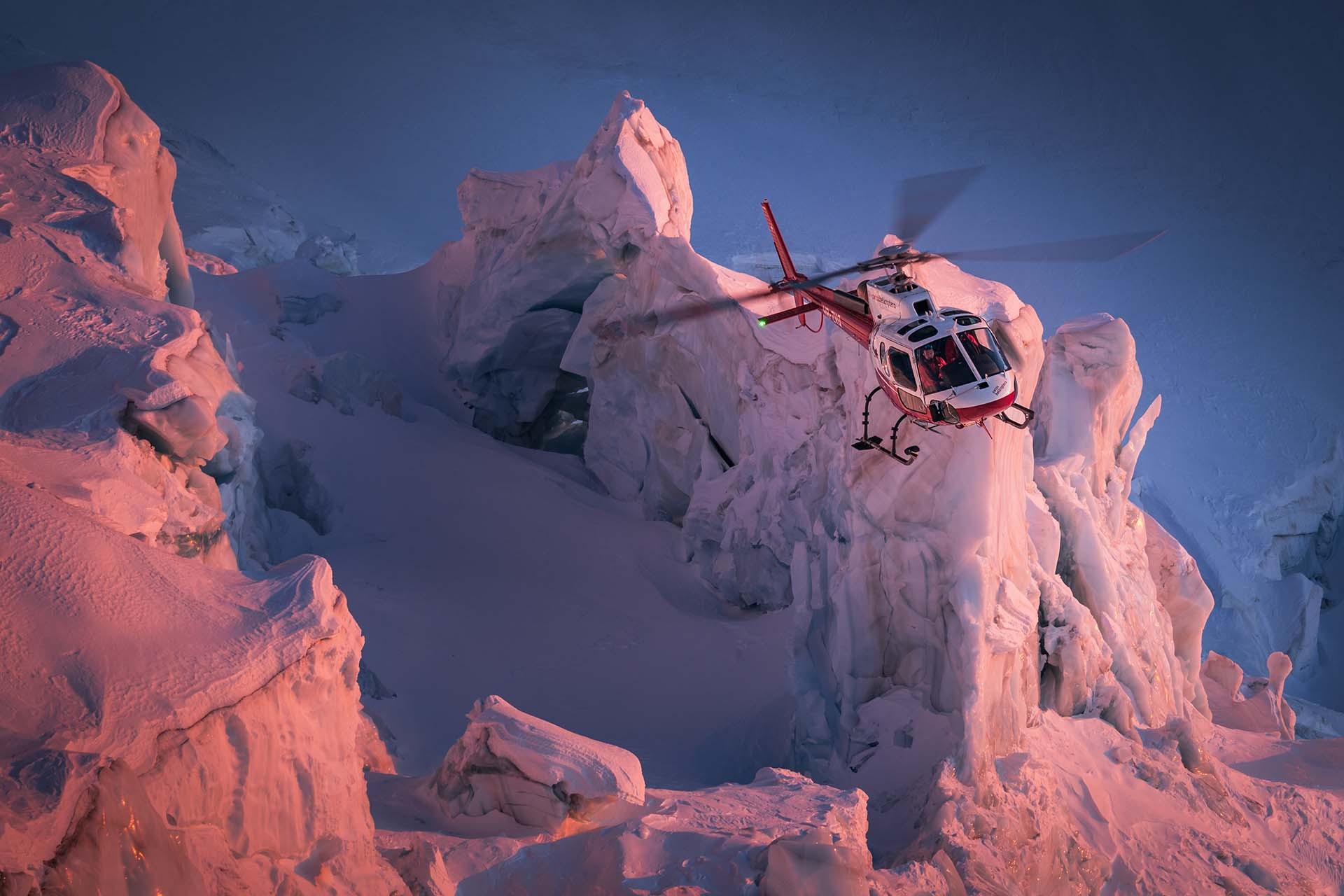In the heart of Europe lies the iconic alpine scenery of the famous Alp mountain range, with views that have stunned, shocked, and amazed admirers for generations. Catching the spectacular views from the air, however, comes at the cost of contending with some of the most perilous flying scenarios. Deep valleys, towering cliffs, high altitudes and extreme weather create unique and hazardous flight conditions. The Swiss have a long history of taming these dangerous mountains with their world-famous engineering and they continue to do so in the world of aviation, establishing high training standards for helicopter mountain flying.
Swiss Helicopter
Swiss Helicopter is Switzerland’s leading helicopter company and was founded in 2012, with the merger of the former Heliswiss, Air Grischa, Bohag, Eliticino, Heli Gotthard and Rhein Heli. From fourteen locations covering the entire country, it operates a massive fleet of twenty H-125s, six H-120s, six Cabri G2s, a pair of KA 32s and one Super Puma. The diverse fleet facilitates a wide range of services to the public and while cargo transportation comprises most of the business, the company also offers flight instruction (with a current roster of 23 instructors), heli-logging, surveying, film and photography work, sightseeing tours, heli-skiing and skydiving.
Flight training is conducted from six of Swiss Helicopter’s bases and one of the main training facilities is at the Bern airport, a location shared with sister company Swiss Helicopter Maintenance, an EASA Part-145 certified maintenance organization. Situated in the valley northwest of the Alps, Bern airport is ideally located for training with enough traffic to familiarize students with airport operations, but small enough to not be too busy. A quick 15–20-minute flight takes you from the 510m (1673ft) valley to the ‘Top of Europe’ – the highest European rail station at 3,454 m (11,332 ft) – and the 4,158 m (13,642 ft) Jungfrau. Together with the Eiger and Mönch, the Jungfrau forms a massive wall of mountains overlooking the Bernese Oberland and the Swiss Plateau, one of the Swiss Alps’ most distinctive sights.
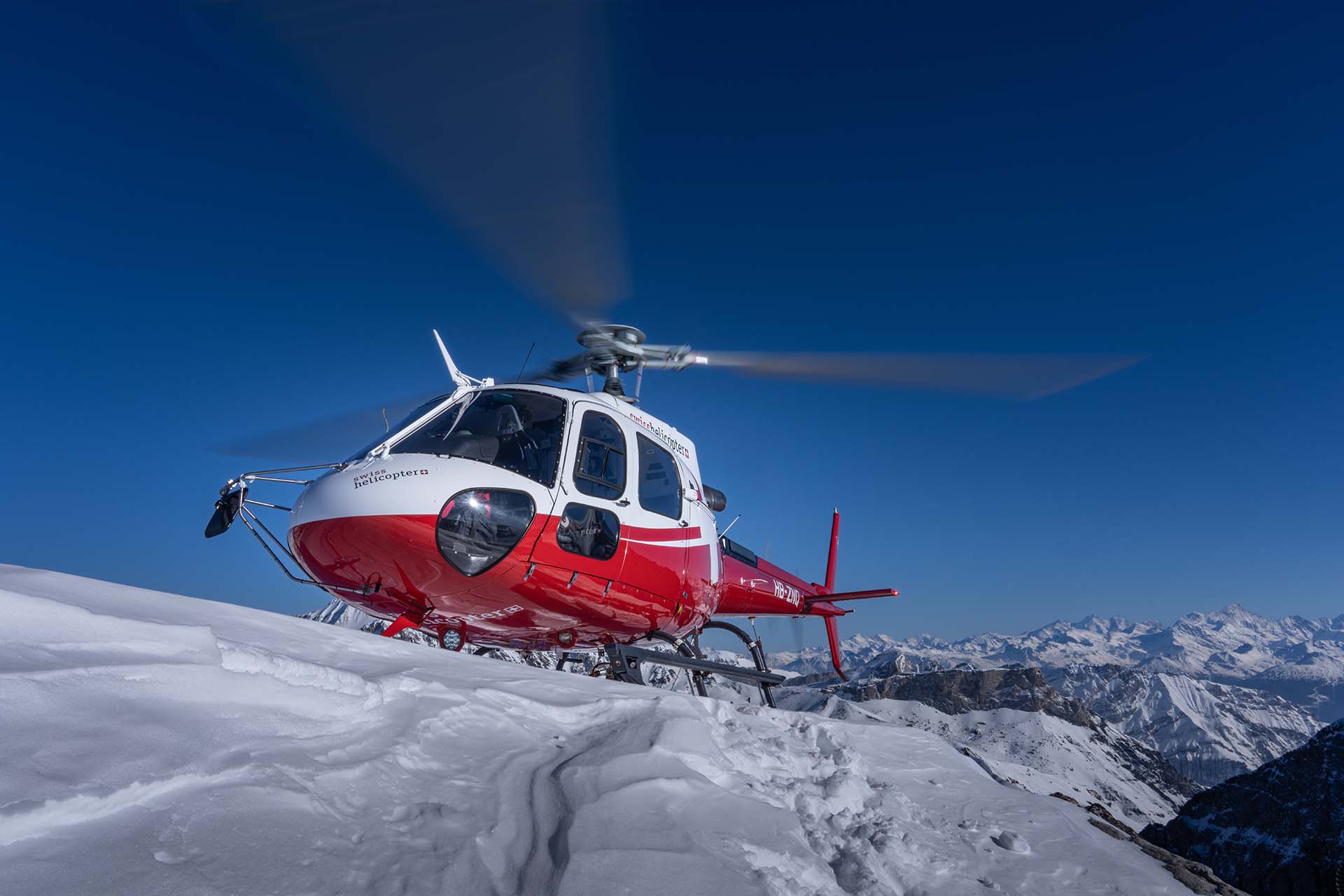
Mountain Training
With the appropriate license, all helicopters can be flown and landed at an elevation at or below 1,100m (3,608 ft), but with an average elevation of 1,350m (4,429 ft) Switzerland is one of the world’s highest countries. The highest point is the 4,634m (15,203 ft) Dufourspitze and the lowest is Lake Maggiore at 193m (633 ft) – all within a country less than one quarter the size of the state of Florida – and very few countries have as diverse a landscape as Switzerland in which to fly. Landings above 2,000m (6,561 ft) must be at one of 40 published mountain landing sites. These have no infrastructure and serve as locations for training and passenger transport purposes. Landings above 1,100m requires the pilot to have an MOU (mountain training) endorsement. This training is unique to Switzerland, regulated by the Swiss Federal Office of Civil Aviation (FOCA), and highly regarded outside the country's borders. FOCA falls under the umbrella of the Federal Department of the Environment, Transport, Energy and Communications (DETEC) and is tasked with ensuring that the high safety standards in civil aviation in Switzerland are maintained, with responsibility for aviation development and the supervision of civil aviation activities in Switzerland.
MOU training covers high-altitude landings on official sites at up to 4,200m (13,779 ft) and includes at least 200 landings in the mountains, 50 of which are up to 2,000m, and 150 above 2,000m. Flights must take place in at least 20 different locations, ten of which must be at more than 2,700m (8,858 ft), and the student pilot must also complete ten high-altitude solo circuits. Pilots will accumulate at least 100 hours of flight time in completing the MOU course and although the majority participants are Swiss nationals, plenty of foreign pilots cross the border to get this world-renowned flight training. Only pilots with a Swiss license get the actual MOU rating, but foreign pilots receive a MOU certificate after completing the skill test.
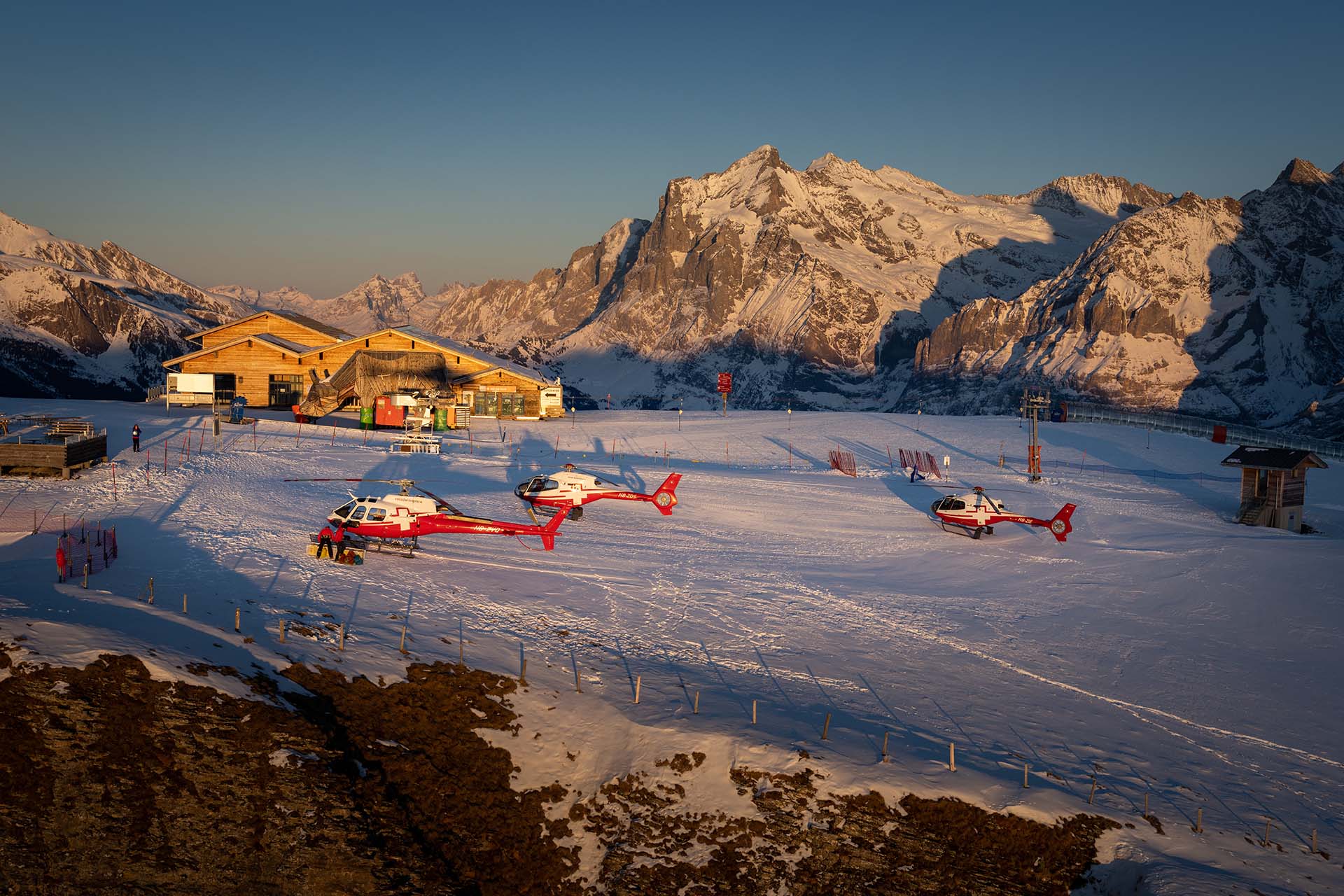
Julian Beermann is one of six MOU instructors for Swiss Helicopters and began flying with the company in 2010. He has been instructing the last five years and with ten years of experience mountain guiding and paragliding, he brings a wealth of alpine knowledge. So much time spent in the mountains and learning local wind flows for unpowered flight has made Beermann a font of mountain flying wisdom. Helicopter flight in the alpine environment is highly specialized because of the consistent high altitude off-site landings in changing weather situations. "Most, if not all professional pilots, in Switzerland will be doing a majority of their landings externally," said Beermann. "MOU training teaches you to follow and work with the terrain and winds. It confronts the student with real life scenarios of off-airport operations. Reading the terrain, weather, local wind systems, and having an escape route is the stuff you don't learn just flying at airports. To be a good mountain flyer you need to have a good feel for your aircraft. Mentally, you must always be ahead of it. You need to be able to read the terrain and have good situational awareness of the right kind for alpine operations. You need a good understanding of the local wind system and weather." He noted that while mountain flying can be simulated and studied in theory, it needs to be learned by experience. "Bravery and courage are not what's most important. If you find yourself in a situation where you need to be brave or courageous, then you are probably in the wrong spot," he concluded.
MOU Aircraft
Swiss Helicopters uses three different aircraft for MOU training: the Guimbal Cabri G2, Airbus H-120, and Airbus H-125. The two-seat, piston-powered G2 is ideal for lower-level landings, as Beermann observed. "Of course, the power is not sufficient for the high landings we do above 4,000m but we can go right up to the limit with this aircraft and it's the perfect platform for landings up to 2,000m, which we can do all year round. It's a very nice platform and the cockpit philosophy is very close to the bigger Airbus aircraft, the H-120 and H-125." Landings above 2,000m are practiced in the H-120, which Julian considers to be the best aircraft for the high-altitude landings. "We have sufficient power for all mountain landing sites within Switzerland, reaching up to above 4,000m. It's not endless power though, so the student is regularly confronted with limits and has to think about how much fuel to take and so on." They do offer training in the H-125 but Beermann says this is not preferred because its available performance does not teach real limitations, so artificial limitations are imposed. "The H-125 is a very nice aircraft to fly while doing the mountain training but if you're in there with just your flight instructor, in most cases you will be flying at artificial power limits and not being confronted with the real limit of the aircraft." This and the H-125’s higher operating cost make the H-120 the aircraft of choice.
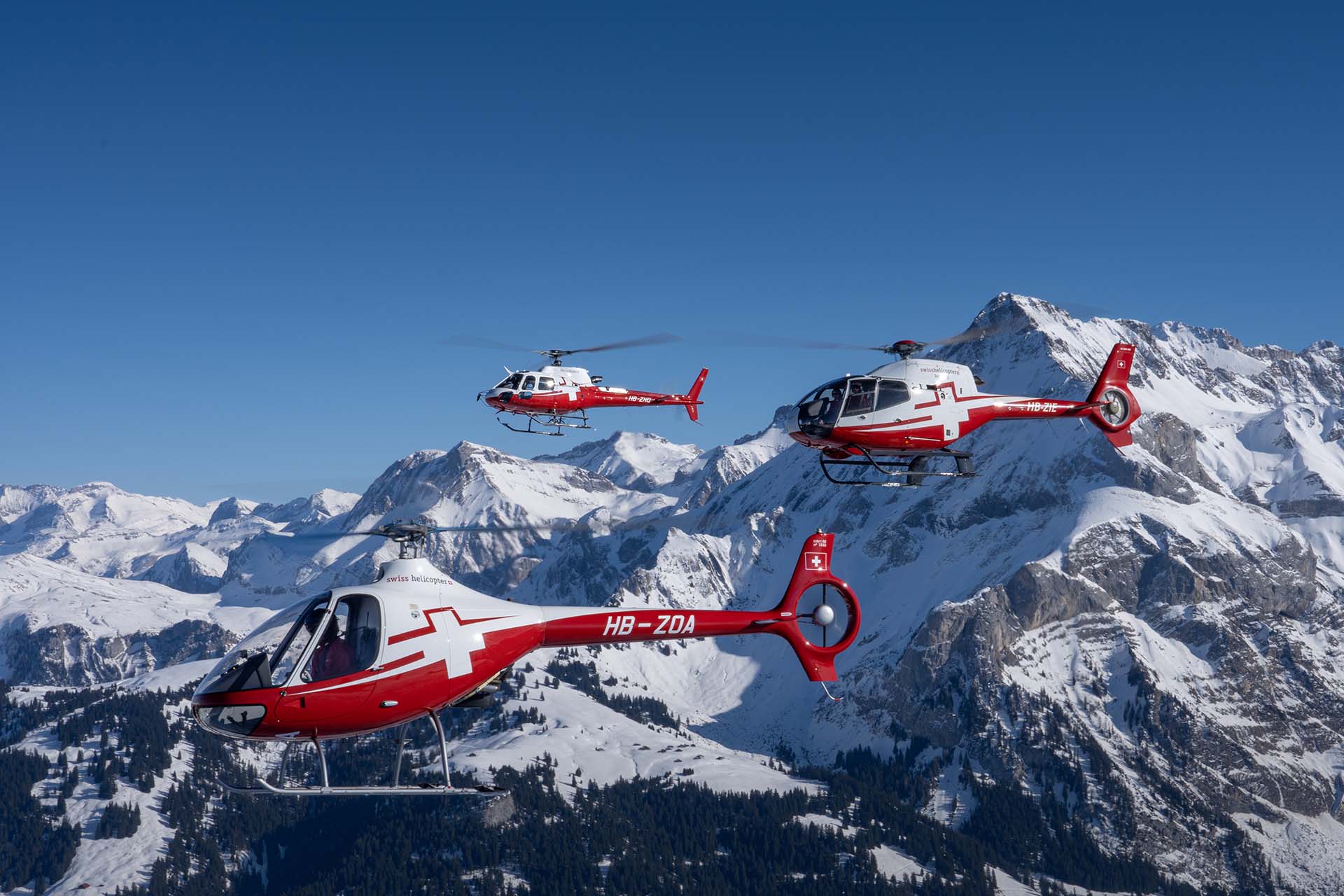
Wind is Key
Wind is by far the biggest game changer when mountain flying but alpine terrain is vast and empty, providing only limited options for external wind markers. Thankfully, most students enter into MOU training already having off-site experience and this challenging landscape creates an opportunity to learn how to read local wind flows. Vegetation in the warmer seasons and blowing snow in the winter are the best indicators but when the landscape is frozen over, judging winds can be tricky. Monitoring wind speed and direction using external indicators, forecasts and ground speed/airspeed calculations are key to being a good pilot, but knowing how local mountain winds flow takes experience.
Winds funnel and accelerate through passes, while sun-exposed faces heat up and draw valley air upwards. Wind in the mountains is not only horizontal but also has a substantial vertical component. "We do have techniques to calculate true airspeed and compare it with ground speed to evaluate the wind, but situations with only a little wind are actually trickier to evaluate. If you are right at your power limit, even a little bit of tailwind can be something you want to avoid. If you have 30 knots of wind, it's usually very, very easy to determine that it's quite strong and where it's coming from," Beermann related. High wind days provide unique training opportunities on some of the landing sites. A single landing site can offer a plethora of training scenarios as the winds shift from different directions, so a student can learn to use the wind to their advantage with different approaches. It can either help by reducing the power required for an operation, or it can incapacitate them by increasing power demand beyond the maximum power available. "Wind is not only our enemy, it can also help if the terrain is appropriate. We like to do some lessons in strong wind to show how to work with it and not against it, which is a very important skill for every pilot. In order for the students to understand the influence of the terrain, especially on the windward side, we have to fly with stronger winds at some stage."
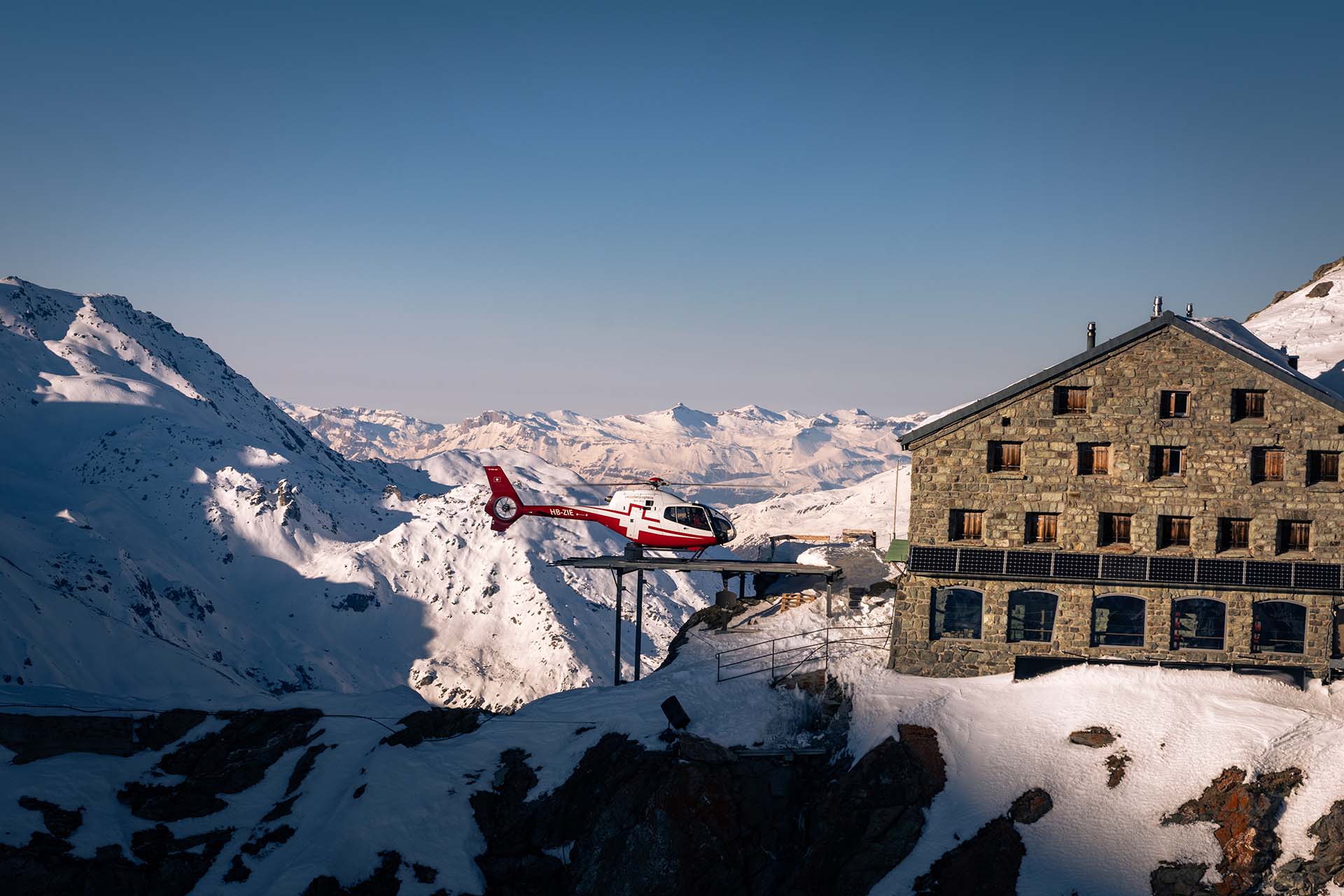
Cable Danger
Cables are a major danger when mountain flying in Switzerland and obstacle avoidance is part of MOU training. The mountainous topography, infrastructure inaccessible by road and reliance on agriculture mean that Switzerland boasts one of the highest concentrations of cableways in the world. From ski lifts, and gondolas to electrical and utility lines, these cables are everywhere, and wire strikes are a leading cause of accidents. Limited morning and evening light, deep valleys, and dense vegetation make these cables are virtually invisible. Most of these cables and obstacles are below 2000m, making flying and landings at these altitudes more dangerous. Obstacles are constantly changing and any cable above 25m is required by law to be reported and added to an online database which is updated monthly. Aircraft are equipped with ‘FLOICE’ or ‘FLARM’ device, which alerts pilots to fixed hazards such as power lines, cable cars, and cell towers with a visual warning on the device and an audio warning in the headset when close to an obstacle that is in the database. Students study and brief on the high-quality Swiss obstacle maps before each flight and some landings are performed close to these obstacles to teach the student situational awareness, technique, and flying tactics to cope with such proximity.
The deep valleys and other natural obstacles tend to funnel traffic into concentrated areas, especially in scenic areas and popular paragliding soaring locations, so a constant watch must be maintained for other aircraft, skydivers, and paragliders. The student learns to constantly have their head on a swivel, monitoring the area for traffic that can be almost invisible in lowlight conditions. Although all aircraft are required to self-report on the common mountain frequency, this cannot be depended upon and non-powered aircraft such as paragliders aren't usually equipped with radios. The FLARM system also detects and reports other aircraft transponders within a given range. Flying at or below 600m (2,000 ft) in the Alps is within class-G airspace, with visibility requirements of 5km and remaining clear of clouds. Helicopters may operate down to 800m visibility, if maneuvered at speeds that give adequate opportunity to observe other traffic and avoid collision, while flights at less than 800m visibility are permitted in special circumstances, such as medical fights and SAR.
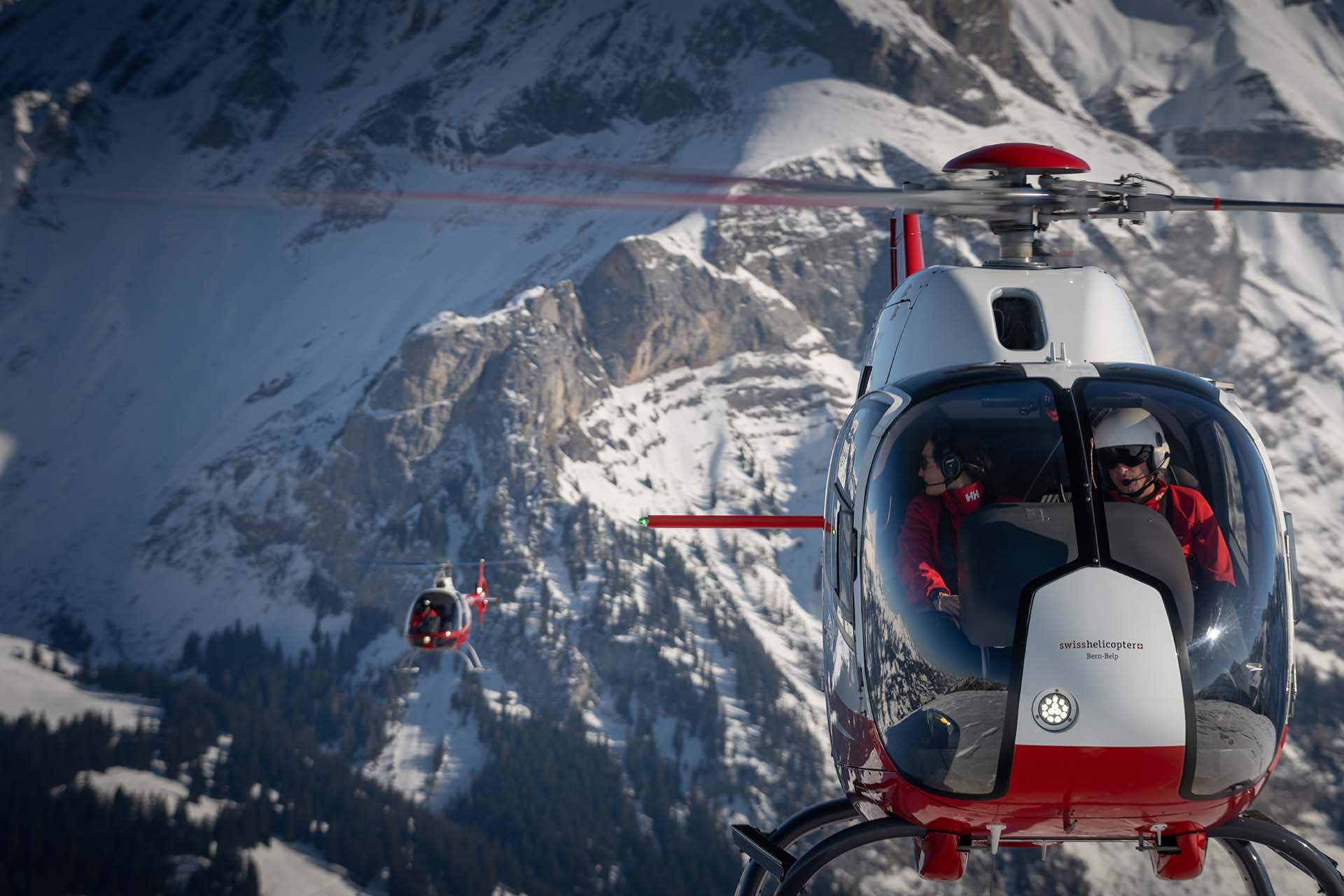
Seeing
Students are introduced to the dangers of the different whiteout conditions and diffused lighting. Diffused light conditions can occur when clouds and time of day alter the lighting conditions. This is especially true on snow-covered surfaces, where the diffused light can diminish contrast and obscure the terrain's structure. The resulting type of whiteout makes it difficult to clearly perceive the surroundings. Large expanses of unbroken snow with no defining surface texture can merge with the sky, eliminating visual surface clues. In the classic whiteout, fresh snow is circulated in the rotor wash when descending into a hover, creating a uniformly white glow that causes all outside reference to be lost and leading to disorientation and controlled flight into terrain. Beermann elaborated, "Even without any blowing snow, a homogeneous snow surface in diffused light can make an approach impossible because it's very hard or impossible to judge your height above ground and your speed on final. Those are situations we try to get into in a controlled way. During mountain training a student is shown a landing they have approached in good conditions, then shown how diffused light - even with good wind conditions and ample power margin – can make an easy spot very challenging or even impossible." Because most students in the MOU program have little more than the minimum 100 hours experience, they are not ready to learn the advanced techniques for bad whiteout conditions that can be taught to 3,000-4,000hr-plus pilots, as there is little margin for error. "We need to teach them safe ways of flying in the mountains. We don't need to show them everything that's possible, so we will just avoid more extreme whiteout conditions. Our goal is to get the students to a point where they have some experience with whiteout, see how quickly it can deteriorate and how difficult it can be." Anticipating the conditions and knowing one’s limits mitigates these dangers and students learn the importance of precisely approaching a reference point on every landing, so they can still fly precisely if a whiteout occurs.
A common mistake among MOU students is not maintaining a level pattern altitude, as the uneven terrain makes it is easy to lose the horizon. When turning away from a spot the terrain may descend rapidly, confusing horizontal perception and creating a tendency to follow the terrain, resulting in a poorly setup approach. It is not uncommon for newer pilots to go-around because they are too high, low, slow or fast. It is difficult to judge distance and scale in the mountains, especially when confronted with uniform featureless terrain but time and experience give students a better perception of this. Beermann wants his students to always have a way out of any approach in their mind. "For me, the most important thing in mountain flying is to always have an escape. So, on every approach, while wind is one factor to evaluate the possible escape path from the approach is at least as important. We need to keep in mind that we must never fly into a situation with no escape at all," he stressed.
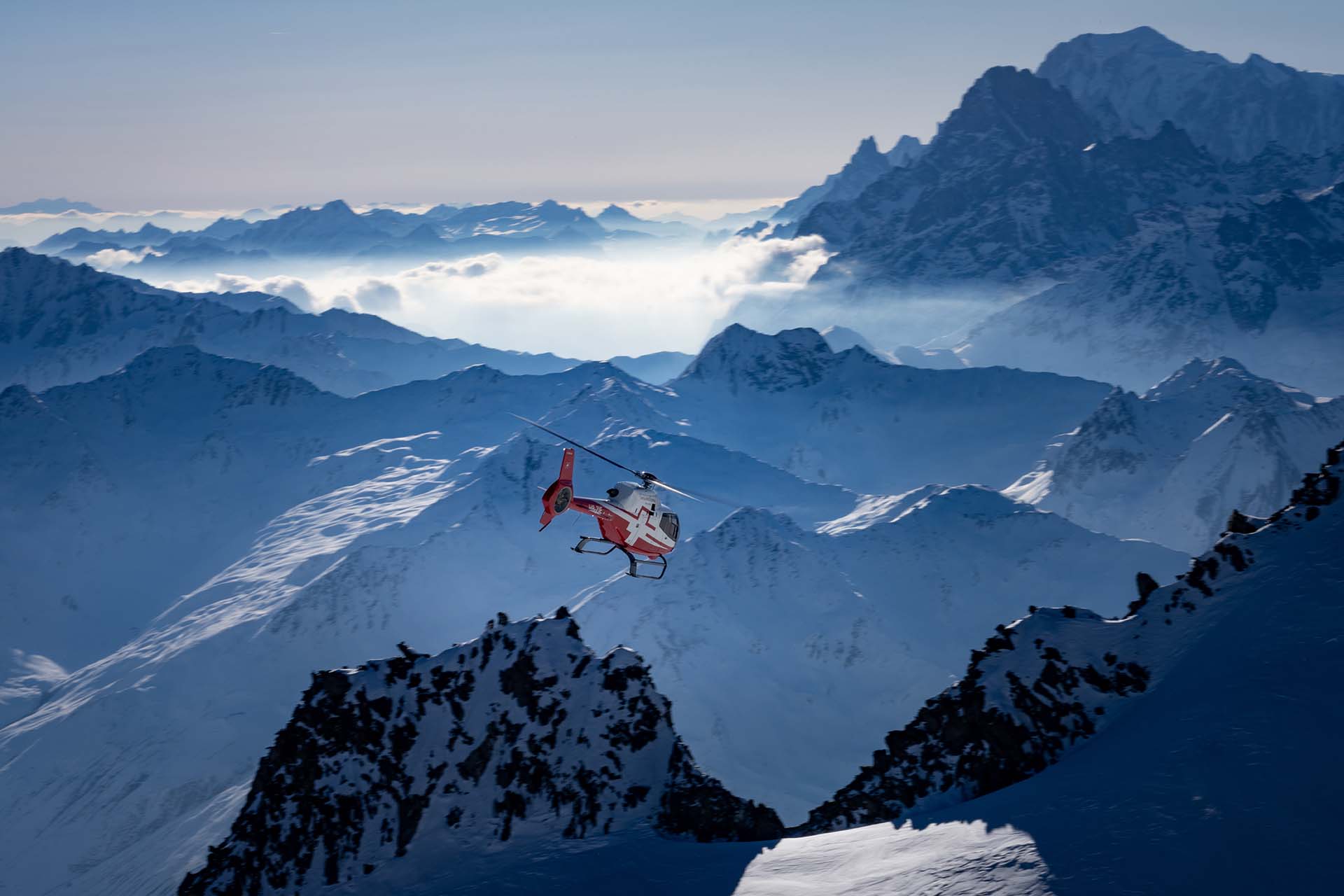
High DA
Students get hands-on experience flying at high density altitudes. This affects not only aircraft performance but also cognitive performance. Altitude sickness and fatigue can be real issues at these elevations. "At high density altitudes we are operating at reduced aircraft performance and reduced human performance, so we always have to keep this in mind," noted Beermann. In Switzerland, supplemental oxygen is required for flights longer than 30 minutes at pressure altitudes between 10,000ft and 13,000ft. This usually isn't a factor when dropping off commercial passengers but most of the flight time on a two-hour training flight is in the zone requiring supplemental oxygen. This is enough exposure to diminish brain performance and decision making so it is Swiss Helicopters’ standard practice to equip each MOU training aircraft with a removable oxygen kit to mitigate the risk for students and trainers.
Manuel Spuhler is one of thirty students currently taking the MOU course. He always dreamt of flying and started through Switzerland's SPHAIR program, a government initiative that seeks and recruits talented young people to be commercial or military pilots. Specialists from civil and military aviation examine and prepare the candidates in a multi-stage process. Candidates are then tested for their suitability to be later recruited for air force, army or general aviation. The SPHAIR certificate is a seal of quality attesting to the talent and commitment of the candidates, and a ticket to the professional aviation realm of Switzerland. The MOU course has taught Spuhler the importance of preparation. "Here, more than any other flight, preparation is very key. You can look at maps, satellite imagery and photos and just really find out, ‘Okay, how am I going to find this place?’ It's just some random mountain and there is probably no house there, no flag, nothing. It is about calculating performance on the move and I tell that to people who think you don't need math outside of school," he commented.
Planning
Before each training flight students plan their routes, brief on obstacles and forecasted weather, calculate performance and fuel loading. OGE hover performance is used for all the mountain sites. Switzerland has a vast network of weather stations, with 260 automatic sites covering the country to provide real time data for route planning. New spots are navigated by paper maps but for familiar landing sites, students are allowed to use tablets.
Old-school flight planning is still taught but digital methods are incorporated into the training, as navigating with a tablet can be very distracting if you have never used one for flight. MOU training can be accomplished in two to three weeks, dependent on good weather. It is preferred and recommended to spread the flights out over the course of a full year, however, as the training is very demanding, especially to newer pilots. There is no time limit to complete the course, so it can be done at your own pace and spreading the training over a whole year allows experience in all seasonal weather conditions, from hot-and-high in the summer to whiteout conditions in the winter. Swiss Helicopter offers a comprehensive range of training options, including PPL, type ratings, CPL, night flying and the MOU course. Beermann enthused, "Mountain flying is the nicest way of helicopter flying for me and I love it! I think the mountain flying course is something where candidates can progress the most in their flying skills. You'll be flying in an absolutely amazing landscape and amazed at the skills you can reach here."
Although mountain flying involves added risk, it brings truly spectacular views and really showcases the capabilities of the pilot and machine. The skilled, well-trained pilot can manage those risks to perform missions that no other aircraft can do – whether they be mountain rescues, utility work, logging or heliskiing – and prove what helicopters can bring to what would otherwise be inaccessible terrain.
 HOME
HOME


